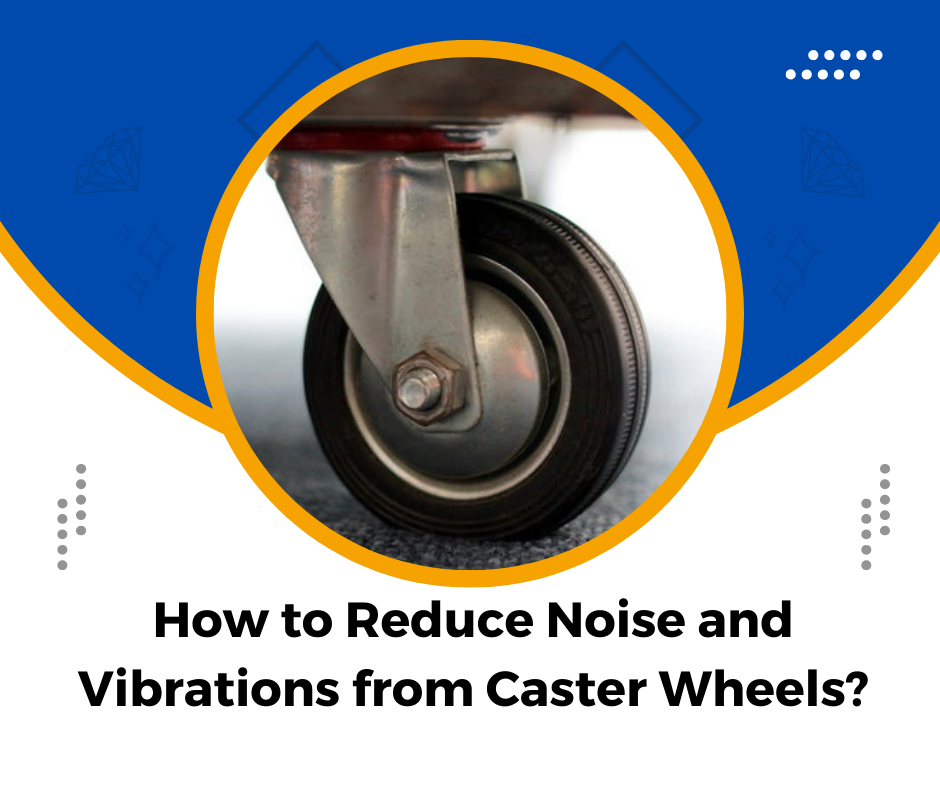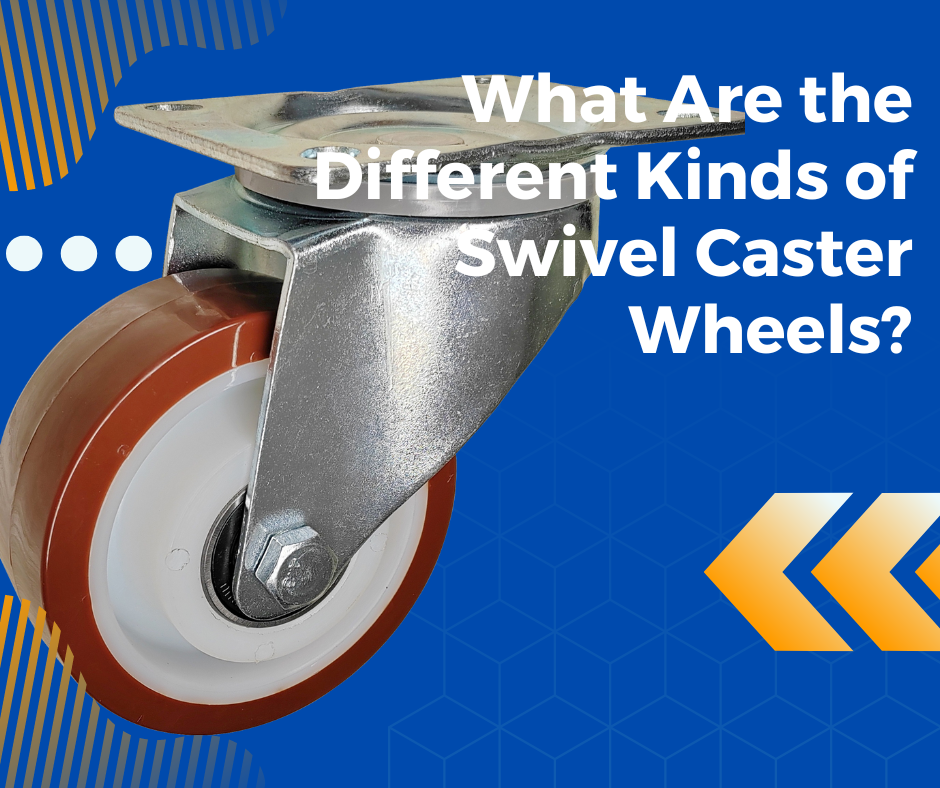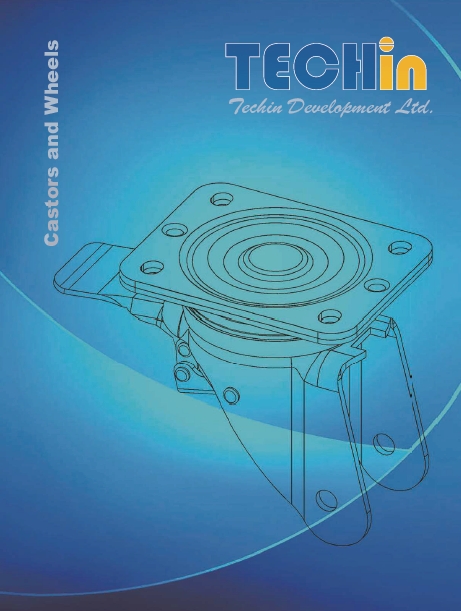Noise and vibrations from your caster wheels can be a real pain in the butt. They can disrupt your work, annoy you at home, and even cause damage to your floors and equipment. But don’t worry, there are some things you can do to make your caster wheels quieter and smoother.
To reduce noise and vibrations from your caster wheels, you need to do regular maintenance like lubricating your wheels and axles. You can also use softer wheel materials, put anti-noise strips on your wheels, and replace your wheels when they get worn out. Shock-absorbing casters and making sure you have your weight distributed properly will also help cut down on vibrations.
Let’s dive into these solutions a little deeper so you can have a quieter environment with your caster wheels.
How to Make Caster Wheels Less Noisy?
One way to cut down on caster wheel noise is to use softer wheel materials. The harder the wheel, the more floor chatter you’re going to get, especially if you have a hard floor. Softer wheel materials can really cut down on the noise.
Table: Comparison of Wheel Materials for Noise Reduction
| Wheel Material | Noise Level | Durability | Ideal Surfaces |
|---|---|---|---|
| Hard Plastic | High | High | Smooth, hard surfaces |
| Steel | High | Very High | Industrial, rough surfaces |
| Rubber | Low | Moderate | All surfaces, quiet areas |
| Polyurethane | Low | High | Mixed surfaces |
| Thermoplastic | Low | Moderate | Indoor, non-abrasive areas |
Rubber Wheels: Rubber wheels are some of the quietest wheels you can get. They’re soft, so they absorb a lot of the vibrations that happen when you’re rolling over different surfaces. Rubber wheels are great for places where you really need to cut down on noise, like offices, hospitals, and libraries. The only downside is that they may wear out quicker if you’re rolling around heavy stuff.
Polyurethane Wheels: Polyurethane wheels are a good balance between noise reduction and durability. They’re softer than hard plastic or steel wheels, so they cut down on noise, but they’re also more durable than rubber wheels. You can use polyurethane wheels in a lot of different places, including industrial settings where you want to cut down on noise.
Thermoplastic Wheels: Thermoplastic wheels cut down on noise and are lightweight, so they’re easy to roll around. They give you a nice, smooth ride and they don’t leave marks on your floor, so you can use them indoors on a lot of different types of floors. The only downside is that they may not be as durable as polyurethane wheels if you’re rolling around heavy stuff.
Lubricate Both Wheels and Axles
Regular lubrication reduces friction, preventing squeaks and rattles. Use appropriate lubricants for the wheel material.
Steps to Lubricate Caster Wheels:
- Gather materials: Soft clothes, suitable lubricant (e.g., WD-40), a small brush, and rubber gloves.
- Clean the wheels: Remove any dirt or debris from the wheels and axles.
- Apply lubricant: Use the lubricant on both the wheels and the axles.
- Wipe excess lubricant: Ensure there’s no excess lubricant that could attract dirt.
Choosing the Right Lubricant:
- For metal wheels and axles, use a light machine oil or a silicone-based lubricant.
- If you have plastic or rubber wheels, don’t use petroleum-based lubricants because they can break down the material. Use a silicone spray or a dry lubricant instead.
Install Anti-Noise Strips
Anti-noise strips absorb vibrations and minimize impact noise, providing a buffer between the wheel and the surface. Here’s how you can install them:
- Purchase anti-noise strips compatible with your caster wheels.
- Clean the wheel surface where the strips will be applied.
- Cut the strips to the required length.
- Adhere the strips to the wheel, ensuring they are firmly in place.
Benefits of Anti-Noise Strips:
- They reduce the noise generated by the contact between the wheel and the floor.
- They absorb shocks and vibrations, enhancing the overall smoothness of the ride.
- They are easy to install and cost-effective.
Replace Old or Worn Caster Wheels
Check your wheels regularly for signs of wear. When they start to wear out, replace them with good-quality wheels so you can keep rolling around quietly and smoothly.
Table: Signs of Wear in Caster Wheels
| Sign of Wear | Description | Solution |
|---|---|---|
| Flat Spots | Uneven wear on the wheel surface | Replace the wheel |
| Cracks or Splits | Visible damage to the wheel material | Replace the wheel |
| Squeaking or Rattling | Noise during movement | Lubricate or replace |
Steps to Replace Caster Wheels:
- Identify the type and size of the caster wheel you need.
- Purchase replacement wheels from a reputable supplier.
- Remove the old wheels by unscrewing or unbolting them from the equipment.
- Install the new wheels, ensuring they are securely attached and properly aligned.
Use Shock-Absorbing Casters
Shock-absorbing casters cut down on vibrations and noise by absorbing the impact and movement of your load, which helps protect your stuff and your floor. They’re especially good if you’re rolling around on uneven surfaces or if you have sensitive equipment.
Types of Shock-Absorbing Casters:
- Spring-Loaded Casters: These casters use springs to absorb shocks and vibrations. They’re great if you’re moving your equipment around on rough or uneven surfaces a lot.
- Pneumatic Casters: These casters have air-filled tires that do a great job of absorbing shocks. They’re good for outdoor use and if you’re rolling around on really rough terrain.
Benefits of Shock-Absorbing Casters:
- They protect sensitive equipment from damage due to vibrations.
- They reduce the noise generated by movement over rough surfaces.
- They improve the comfort and safety of the operator by minimizing the jolts and bumps transmitted through the equipment.
How to Stop Caster Flutter?
If you increase the swivel lead and use casters with precision bearing swivel sections, you can cut down on caster flutter and make your wheels more stable.
- Increase swivel lead: This reduces the forces that push the caster sideways.
- Use precision bearings: These bearings help maintain stability and reduce flutter.
Understanding Caster Flutter:
Caster flutter happens when a caster wheel wobbles back and forth really fast, making noise and making your wheels unstable. This can happen if you’re going too fast, if your load is out of balance, or if your swivel bearings are worn out.
Solutions to Prevent Caster Flutter:
- Ensure the caster wheels are properly aligned and balanced.
- Reduce the speed at which the equipment is moved.
- Use precision bearings to improve the stability of the caster.
DIY Solutions for Reducing Noise and Vibrations
Simple DIY solutions like using softer materials for wheels and ensuring proper lubrication can be effective in noise reduction. Additionally, ensuring proper weight distribution on the caster can help minimize vibrations.
DIY Tips:
- Use Felt Pads: Attach felt pads to the bottom of equipment legs to reduce noise and vibrations.
- Add Weight to Light Equipment: Adding weight can help stabilize light equipment and reduce vibrations.
- Check Floor Surface: Ensure the floor surface is clean and smooth to minimize noise and vibrations.
What Are the Best Materials for Quiet Caster Wheels?
Discuss materials like rubber, polyurethane, and thermoplastic, and their benefits in noise reduction.
- Rubber: Offers good noise reduction and smooth operation. Suitable for environments where quiet movement is essential.
- Polyurethane: Combines durability with noise-dampening properties. Ideal for mixed surfaces and heavy loads.
- Thermoplastic: Lightweight and provides a cushioned ride. Suitable for indoor use on various floor types.
Table: Benefits of Different Caster Wheel Materials
| Material | Noise Reduction | Durability | Applications |
|---|---|---|---|
| Rubber | High | Moderate | Offices, hospitals, libraries |
| Polyurethane | High | High | Industrial settings, warehouses |
| Thermoplastic | Moderate | Moderate | Indoor use, non-abrasive floors |
How Often Should You Lubricate Caster Wheels?
Explain the frequency and process of lubrication for maintaining quiet operation.
- Frequency: Lubricate every 3-6 months, or more often if the wheels bear heavy loads.
- Process: Clean, apply lubricant, and remove excess.
Steps for Regular Lubrication:
- Clean the wheels and axles to remove any dirt or debris.
- Apply a small amount of lubricant to the wheel bearings and axles.
- Rotate the wheels to distribute the lubricant evenly.
- Wipe away any excess lubricant to prevent dirt buildup.
Can Caster Wheels Damage Flooring?
Discuss the impact of different caster materials on various flooring types and how to prevent damage.
Impact on Different Flooring Types:
- Hardwood Floors: Hard wheels can cause scratches and dents. Use soft wheels like rubber or polyurethane to prevent damage.
- Tile Floors: Hard wheels can crack or chip tiles. Use wheels with a soft tread to minimize the risk.
- Carpeted Floors: Hard wheels can get stuck or cause wear. Use larger wheels with a smooth tread for easier movement.
Preventing Floor Damage:
- Use Floor Protectors: Install caster cups or floor mats to protect the flooring.
- Regular Maintenance: Keep the wheels clean and free of debris that could cause scratches.
- Choose Appropriate Wheels: Select wheels that are suitable for the type of flooring in your environment.
How to Reduce Vibrations from Caster Wheels on Uneven Surfaces
Provide tips for using shock-absorbing casters and other methods to minimize vibrations on uneven terrain.
Using Shock-Absorbing Casters:
- Spring-Loaded Casters: These casters have internal springs that absorb shocks and vibrations, making them ideal for uneven surfaces.
- Pneumatic Casters: These casters have air-filled tires that cushion impacts and reduce vibrations, suitable for outdoor and rough terrains.
Additional Tips:
- Evenly Distribute the Load: Ensure that the load on the equipment is evenly distributed to prevent imbalance and reduce vibrations.
- Use Rubber or Polyurethane Wheels: These materials absorb shocks better than hard plastic or metal wheels.
- Install Vibration Dampening Pads: Place pads between the equipment and the caster wheels to further reduce vibrations.
How to Install Anti-Noise Strips on Caster Wheels
A step-by-step guide to installing anti-noise strips effectively.
- Measure the Wheels: Determine the circumference of your caster wheels to know the length of anti-noise strips required.
- Clean the Wheels: Ensure the wheels are free from dust, dirt, and grease.
- Cut the Strips: Cut the anti-noise strips to match the measured length.
- Apply the Strips: Adhere the strips to the perimeter of the wheels, ensuring they are firmly attached and smooth.
Benefits of Anti-Noise Strips:
- Noise Reduction: Significantly reduces the noise generated by the wheels.
- Vibration Dampening: Helps in minimizing vibrations.
- Enhanced Durability: Protects the wheels from wear and tear.
What Are the Benefits of Shock-Absorbing Casters?
Highlight the advantages of using shock-absorbing casters for noise reduction and protection of equipment.
Advantages:
- Noise Reduction: Shock-absorbing casters reduce the noise produced by equipment movement, creating a quieter environment.
- Protect Equipment: Absorb shocks and vibrations, reducing the risk of damage to sensitive equipment.
- Improved Mobility: Easier to move over uneven surfaces, reducing operator fatigue.
- Enhanced Safety: Minimize the risk of accidents caused by sudden jolts and vibrations.
Summary
By paying attention to the type of wheels you’re using, doing regular maintenance, and using things like anti-noise strips and shock-absorbing casters, you can cut down on the noise and vibrations from your caster wheels. Use these solutions to make your equipment quieter and easier to roll around.
Table: Summary of Noise and Vibration Reduction Methods
| Method | Benefits |
|---|---|
| Softer Wheel Materials | Reduces noise and improves ride quality |
| Regular Lubrication | Prevents squeaks and prolongs wheel life |
| Anti-Noise Strips | Minimizes noise and absorbs vibrations |
| Shock-Absorbing Casters | Reduces vibrations and protects equipment |
| Even Load Distribution | Prevents imbalance and reduces vibrations |
| Floor Protectors | Prevents floor damage and reduces noise |
Implementing these methods will ensure your caster wheels operate quietly and efficiently, enhancing the overall functionality and lifespan of your equipment.







